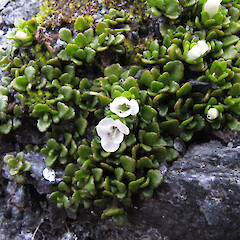Veronica planopetiolata
Synonyms
Parahebe muelleri W.R.B.Oliv., Parahebe palno-petiolata G.Simpson et J.S.thomson) W.R.B.Oliv. var. plano-petiolata, Parahebe planopetiolata (G.Simpson et J.S.Thomson) W.R.B.Oliv.
Family
Plantaginaceae
Flora category
Vascular – Native
Endemic taxon
Yes
Endemic genus
No
Endemic family
No
Structural class
Herbs - Dicotyledons other than Composites
NVS code
The National Vegetation Survey (NVS) Databank is a physical archive and electronic databank containing records of over 94,000 vegetation survey plots - including data from over 19,000 permanent plots. NVS maintains a standard set of species code abbreviations that correspond to standard scientific plant names from the Ngä Tipu o Aotearoa - New Zealand Plants database.
PARPLA
Chromosome number
2n = 84
Current conservation status
The conservation status of all known New Zealand vascular plant taxa at the rank of species and below were reassessed in 2017 using the New Zealand Threat Classification System (NZTCS) – more information about this can be found on the NZTCS website. This report includes a statistical summary and brief notes on changes since 2012 and replaces all previous NZTCS lists for vascular plants.
Please note, threat classifications are often suggested by authors when publications fall between NZTCS assessment periods – an interim threat classification status has not been assessed by the NZTCS panel.
- Conservation status of New Zealand indigenous vascular plants, 2017 . 2018. Peter J. de Lange, Jeremy R. Rolfe, John W. Barkla, Shannel P. Courtney, Paul D. Champion, Leon R. Perrie, Sarah M. Beadel, Kerry A. Ford, Ilse Breitwieser, Ines Schönberger, Rowan Hindmarsh-Walls, Peter B. Heenan and Kate Ladley. Department of Conservation. Source: NZTCS and licensed by DOC for reuse under the Creative Commons Attribution 4.0 International licence.
2017 | At Risk – Naturally Uncommon | Qualifiers: DP, RR, Sp
Previous conservation statuses
2012 | Not Threatened
2009 | Not Threatened
2004 | Not Threatened
Distribution
Endemic. New Zealand: South Island (South Westland, West Otago (Mt Aspiring and Westland National Parks along the main divide); Mt Tyndall; Symmetry Peaks, Eyre Mountains; Fiordland (Mt McPherson; Wapiti Lake))
Habitat
Subalpine to alpine. Inhabiting scree, moraine, fellfield and on cliff faces.
Detailed description
Subshrub, loose cushion or mat-forming subshrub to 50 mm tall. Stems brown. Branches prostrate. Branchlets red-brown. Vegetative internodes 1–7 mm long. Stems glabrous or sparsely bifariously eglandular-pubescent. Leaves erecto-patent to spreading, glabrous except for finely ciliate petioles. Lamina oblanceolate, oblong, elliptic, rhomboid, 2–10 × 1–6 mm; adaxial surface glossy, green or dark green; abaxial surface dull, green, pale green or purple. Leaf hairs absent. Apex obtuse to rounded. Base cuneate. Margin entire or shallowly crenate, teeth or lobes in 0–3 pairs. Petiole 1-5 mm long. Inflorescence 1–(2)-flowered, 5–8 mm long at fruiting. Peduncle 1-2 mm long, glabrous. Bracts paired and opposite, spathulate to obovate, obtuse or subacute, glabrous or basally eglandular ciliate, margins entire. Rachis glabrous. Pedicels 1-7 mm long, glabrous. Flowers: corolla, tube and throat white, pink or violet at anthesis. Nectar guides absent. Calyx 4–(5)-lobed, 3.5–7.0 mm long, glabrous; lobes oblanceolate, obovate or spathulate, obtuse, margins entire, rarely toothed, glabrous. Corolla 7–9 mm diameter, tube 2.0–4.0 × 1.0–1.5 mm wide, lobes glabrous. Stamen filaments white, 1.5–2.5 mm long, not narrowed at base. Anthers magenta, 1 mm long. Nectarial disc minutely ciliolate. Ovary ovoid or fusiform, acute or subacute, glabrous, 1 mm long. Style 2.5–3.5 mm long. Capsules strongly flattened, emarginate or didymous, 3.0–4.0 × 4.0–4.5 mm, glabrous; septicidal split extending to base, loculicidal split extending ¼–½-way to base. Seeds ellipsoid or obovoid, pale brown, 0.8–1.0 × 0.5–0.6 mm.
Similar taxa
Veronica planopetiolata is allied to V. zygantha from which it is distinguished by its more compact growth habit; narrower leaves; sparse or absent stem pubescence—which, if present, is composed of spreading hairs; mostly solitary flowers borne on glabrous pedicels; and the conspicuous presence of stomata on the lower leaf surfaces.
Flowering
November–January
Flower colours
Red/Pink, White
Fruiting
December–April
Propagation technique
Difficult. Best grown in a rock garden or alpine house in a sunny position with a cool root run.
Etymology
veronica: Named after Saint Veronica, who gave Jesus her veil to wipe his brow as he carried the cross through Jerusalem, perhaps because the common name of this plant is ‘speedwell’. The name Veronica is often believed to derive from the Latin vera ‘truth’ and iconica ‘image’, but it is actually derived from the Macedonian name Berenice which means ‘bearer of victory’.
Where To Buy
Not Commercially Available
Attribution
Fact Sheet by P.J. de Lange (5 October 2006). Description adapted from Garnock-Jones and Lloyd (2003).
References and further reading
Garnock-Jones PJ, Lloyd DG. 2003. A taxonomic revision of Parahebe (Plantaginaceae) in New Zealand. New Zealand Journal of Botany 42(2): 181–232. https://doi.org/10.1080/0028825X.2004.9512899.
NZPCN Fact Sheet citation
Please cite as: de Lange, P.J. (Year at time of access): Veronica planopetiolata Fact Sheet (content continuously updated). New Zealand Plant Conservation Network. https://www.nzpcn.org.nz/flora/species/veronica-planopetiolata/ (Date website was queried)





